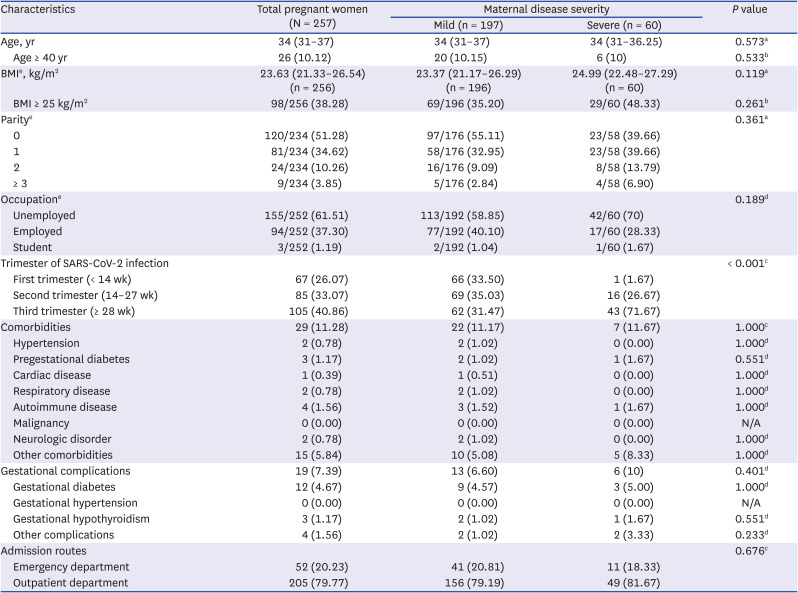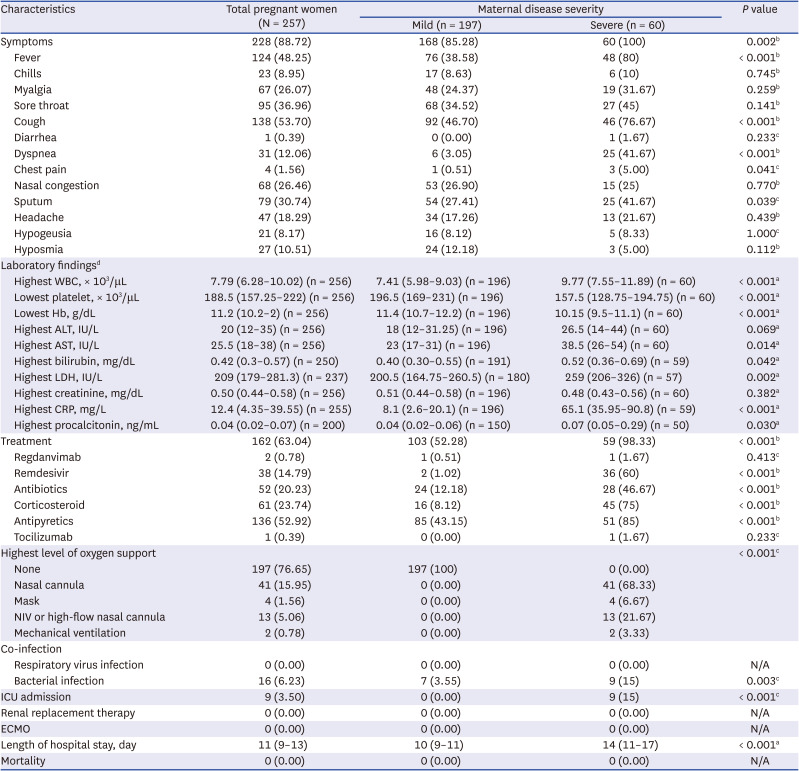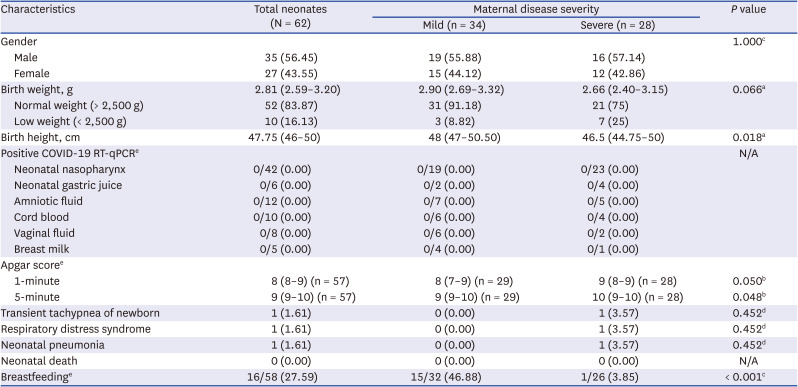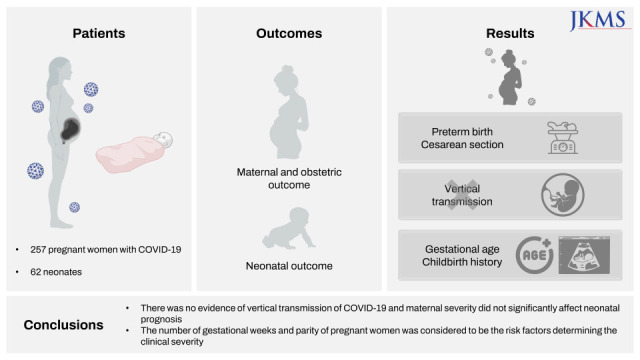1. Wong SF, Chow KM, Leung TN, Ng WF, Ng TK, Shek CC, et al. Pregnancy and perinatal outcomes of women with severe acute respiratory syndrome. Am J Obstet Gynecol. 2004; 191(1):292–297. PMID:
15295381.

2. Lam CM, Wong SF, Leung TN, Chow KM, Yu WC, Wong TY, et al. A case-controlled study comparing clinical course and outcomes of pregnant and non-pregnant women with severe acute respiratory syndrome. BJOG. 2004; 111(8):771–774. PMID:
15270922.

3. Assiri A, Abedi GR, Al Masri M, Bin Saeed A, Gerber SI, Watson JT. Middle East respiratory syndrome coronavirus infection during pregnancy: a report of 5 cases from Saudi Arabia. Clin Infect Dis. 2016; 63(7):951–953. PMID:
27358348.

4. Alfaraj SH, Al-Tawfiq JA, Memish ZA. Middle East respiratory syndrome coronavirus (MERS-CoV) infection during pregnancy: report of two cases & review of the literature. J Microbiol Immunol Infect. 2019; 52(3):501–503. PMID:
29907538.

5. Abdullahi H, Elnahas A, Konje JC. Seasonal influenza during pregnancy. Eur J Obstet Gynecol Reprod Biol. 2021; 258:235–239. PMID:
33476926.

6. Goodnight WH, Soper DE. Pneumonia in pregnancy. Crit Care Med. 2005; 33(10):Suppl. S390–S397. PMID:
16215363.

7. O’Day MP. Cardio-respiratory physiological adaptation of pregnancy. Semin Perinatol. 1997; 21(4):268–275. PMID:
9298715.
8. Zambrano LD, Ellington S, Strid P, Galang RR, Oduyebo T, Tong VT, et al. Update: characteristics of symptomatic women of reproductive age with laboratory-confirmed SARS-CoV-2 infection by pregnancy status — United States, January 22–October 3, 2020. MMWR Morb Mortal Wkly Rep. 2020; 69(44):1641–1647. PMID:
33151921.
9. Villar J, Ariff S, Gunier RB, Thiruvengadam R, Rauch S, Kholin A, et al. Maternal and neonatal morbidity and mortality among pregnant women with and without COVID-19 Infection: the INTERCOVID multinational cohort study. JAMA Pediatr. 2021; 175(8):817–826. PMID:
33885740.

10. Wei SQ, Bilodeau-Bertrand M, Liu S, Auger N. The impact of COVID-19 on pregnancy outcomes: a systematic review and meta-analysis. CMAJ. 2021; 193(16):E540–E548. PMID:
33741725.
11. Woodworth KR, Olsen EO, Neelam V, Lewis EL, Galang RR, Oduyebo T, et al. Birth and infant outcomes following laboratory-confirmed sars-cov-2 infection in pregnancy – SET-NET, 16 Jurisdictions, March 29–October 14, 2020. MMWR Morb Mortal Wkly Rep. 2020; 69(44):1635–1640. PMID:
33151917.

12. Delahoy MJ, Whitaker M, O’Halloran A, Chai SJ, Kirley PD, Alden N, et al. Characteristics and maternal and birth outcomes of hospitalized pregnant women with laboratory-confirmed COVID-19 – COVID-NET, 13 States, March 1–August 22, 2020. MMWR Morb Mortal Wkly Rep. 2020; 69(38):1347–1354. PMID:
32970655.
13. Schwartz DA, Graham AL. Potential maternal and infant outcomes from (Wuhan) coronavirus 2019-nCoV infecting pregnant women: lessons from SARS, MERS, and other human coronavirus infections. Viruses. 2020; 12(2):194.
14. Trocado V, Silvestre-Machado J, Azevedo L, Miranda A, Nogueira-Silva C. Pregnancy and COVID-19: a systematic review of maternal, obstetric and neonatal outcomes. J Matern Fetal Neonatal Med. 2022; 35(12):2362–2374. PMID:
32635775.

15. DeBolt CA, Bianco A, Limaye MA, Silverstein J, Penfield CA, Roman AS, et al. Pregnant women with severe or critical coronavirus disease 2019 have increased composite morbidity compared with nonpregnant matched controls. Am J Obstet Gynecol. 2021; 224(5):510.e1–510.12. PMID:
33221292.
16. Papapanou M, Papaioannou M, Petta A, Routsi E, Farmaki M, Vlahos N, et al. Maternal and neonatal characteristics and outcomes of COVID-19 in pregnancy: an overview of systematic reviews. Int J Environ Res Public Health. 2021; 18(2):596.
17. Simsek Y, Ciplak B, Songur S, Kara M, Karahocagil MK. Maternal and fetal outcomes of COVID-19, SARS, and MERS: a narrative review on the current knowledge. Eur Rev Med Pharmacol Sci. 2020; 24(18):9748–9752. PMID:
33015821.
18. Li N, Han L, Peng M, Lv Y, Ouyang Y, Liu K, et al. Maternal and neonatal outcomes of pregnant women with coronavirus disease 2019 (COVID-19) pneumonia: a case-control study. Clin Infect Dis. 2020; 71(16):2035–2041. PMID:
32249918.
19. Adhikari EH, Moreno W, Zofkie AC, MacDonald L, McIntire DD, Collins RR, et al. Pregnancy outcomes among women with and without severe acute respiratory syndrome coronavirus 2 infection. JAMA Netw Open. 2020; 3(11):e2029256. PMID:
33211113.
20. Handley SC, Mullin AM, Elovitz MA, Gerson KD, Montoya-Williams D, Lorch SA, et al. Changes in preterm birth phenotypes and stillbirth at 2 Philadelphia hospitals during the SARS-CoV-2 pandemic, March–June 2020. JAMA. 2021; 325(1):87–89. PMID:
33284323.
21. Pineles BL, Alamo IC, Farooq N, Green J, Blackwell SC, Sibai BM, et al. Racial-ethnic disparities and pregnancy outcomes in SARS-CoV-2 infection in a universally-tested cohort in Houston, Texas. Eur J Obstet Gynecol Reprod Biol. 2020; 254:329–330. PMID:
32950276.
22. Ahlberg M, Neovius M, Saltvedt S, Söderling J, Pettersson K, Brandkvist C, et al. Association of SARS-CoV-2 test status and pregnancy outcomes. JAMA. 2020; 324(17):1782–1785. PMID:
32965467.
23. Pettirosso E, Giles M, Cole S, Rees M. COVID-19 and pregnancy: a review of clinical characteristics, obstetric outcomes and vertical transmission. Aust N Z J Obstet Gynaecol. 2020; 60(5):640–659. PMID:
32779193.
24. Chi J, Gong W, Gao Q. Clinical characteristics and outcomes of pregnant women with COVID-19 and the risk of vertical transmission: a systematic review. Arch Gynecol Obstet. 2021; 303(2):337–345. PMID:
33258995.
25. Gupta V, Yadav Y, Sharma R, Mishra M, Ambedkar D, Gupta V. Maternal and perinatal outcomes of hospitalized COVID-19 positive pregnant women. Cureus. 2022; 14(2):e21817. PMID:
35261836.
26. Chung Y, Choi DH, Ilagan JG, Lee J, Yoon YK. Maternal outcomes and clinical characteristics of COVID-19 in Korean pregnant women during the early period of the pandemic. J Korean Med Sci. 2021; 36(41):e290. PMID:
34697931.
27. Kim SH, Choi Y, Lee D, Lee H, Kim JH, Choi ES, et al. Impact of COVID-19 on pregnant women in South Korea: focusing on prevalence, severity, and clinical outcomes. J Infect Public Health. 2022; 15(2):270–276. PMID:
35066387.
28. Peepal P, Rath TS, Nayak S, Pendyala S. Maternal and neonatal outcomes among women with and without severe acute respiratory syndrome corona virus-2 infection: a retrospective analytical study. J Mother Child. 2022; 25(2):77–85. PMID:
35139602.
29. Desai A, Gyawali B. Endpoints used in phase III randomized controlled trials of treatment options for COVID-19. EClinicalMedicine. 2020; 23:100403. PMID:
32632415.
31. Ahn KH, Kim HI, Lee KS, Heo JS, Kim HY, Cho GJ, et al. COVID-19 and vaccination during pregnancy: a systematic analysis using Korea National Health Insurance claims data. Obstet Gynecol Sci. Forthcoming. 2022; DOI: 10.5468/ogs.22060.
33. Arco-Torres A, Cortés-Martín J, Tovar-Gálvez MI, Montiel-Troya M, Riquelme-Gallego B, Rodríguez-Blanque R. Pharmacological treatments against COVID-19 in pregnant women. J Clin Med. 2021; 10(21):4896. PMID:
34768416.
34. Cai J, Tang M, Gao Y, Zhang H, Yang Y, Zhang D, et al. Cesarean section or vaginal delivery to prevent possible vertical transmission from a pregnant mother confirmed with COVID-19 to a neonate: a systematic review. Front Med (Lausanne). 2021; 8:634949. PMID:
33681259.
35. Debrabandere ML, Farabaugh DC, Giordano C. A review on mode of delivery during COVID-19 between December 2019 and April 2020. Am J Perinatol. 2021; 38(4):332–341. PMID:
33285608.
36. Parazzini F, Bortolus R, Mauri PA, Favilli A, Gerli S, Ferrazzi E. Delivery in pregnant women infected with SARS-CoV-2: a fast review. Int J Gynaecol Obstet. 2020; 150(1):41–46. PMID:
32271947.
37. Katz D, Bateman BT, Kjaer K, Turner DP, Spence NZ, Habib AS, et al. The Society for Obstetric Anesthesia and Perinatology coronavirus disease 2019 registry: an analysis of outcomes among pregnant women delivering during the initial severe acute respiratory syndrome coronavirus-2 outbreak in the United States. Anesth Analg. 2021; 133(2):462–473. PMID:
33830956.
38. Metz TD, Clifton RG, Hughes BL, Sandoval G, Saade GR, Grobman WA, et al. Disease severity and perinatal outcomes of pregnant patients with coronavirus disease 2019 (COVID-19). Obstet Gynecol. 2021; 137(4):571–580. PMID:
33560778.
39. Eman A, Balaban O, Kocayiğit H, Süner KO, Cirdi Y, Erdem AF. Maternal and neonatal outcomes of critically ill pgrenant and puerperal patients diagnosed with COVID-19 disease: retrospective comparative study. J Korean Med Sci. 2021; 36(44):e309. PMID:
34783218.
40. Allotey J, Chatterjee S, Kew T, Gaetano A, Stallings E, Fernández-García S, et al. SARS-CoV-2 positivity in offspring and timing of mother-to-child transmission: living systematic review and meta-analysis. BMJ. 2022; 376:e067696. PMID:
35296519.
41. Vousden N, Bunch K, Morris E, Simpson N, Gale C, O’Brien P, et al. The incidence, characteristics and outcomes of pregnant women hospitalized with symptomatic and asymptomatic SARS-CoV-2 infection in the UK from March to September 2020: a national cohort study using the UK Obstetric Surveillance System (UKOSS). PLoS One. 2021; 16(5):e0251123. PMID:
33951100.
42. Kumar R, Yeni CM, Utami NA, Masand R, Asrani RK, Patel SK, et al. SARS-CoV-2 infection during pregnancy and pregnancy-related conditions: Concerns, challenges, management and mitigation strategies-a narrative review. J Infect Public Health. 2021; 14(7):863–875. PMID:
34118736.
43. Aydın GA, Ünal S, Özsoy HG. The effect of gestational age at the time of diagnosis on adverse pregnancy outcomes in women with COVID-19. J Obstet Gynaecol Res. 2021; 47(12):4232–4240. PMID:
34585464.










 PDF
PDF Citation
Citation Print
Print




 XML Download
XML Download